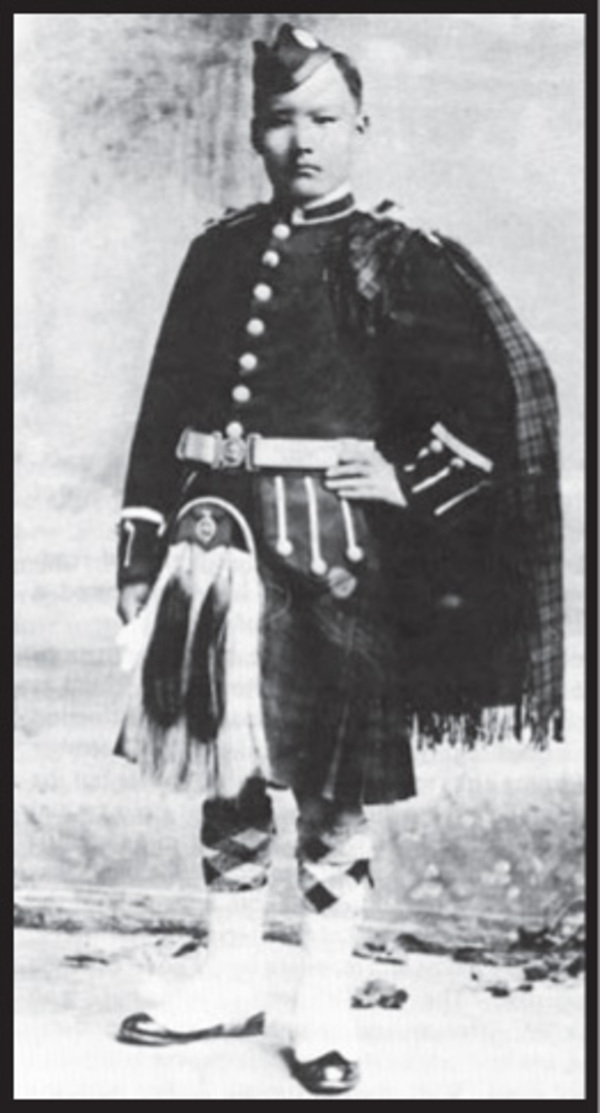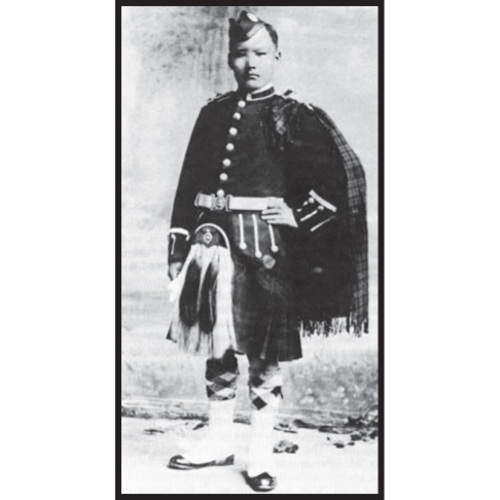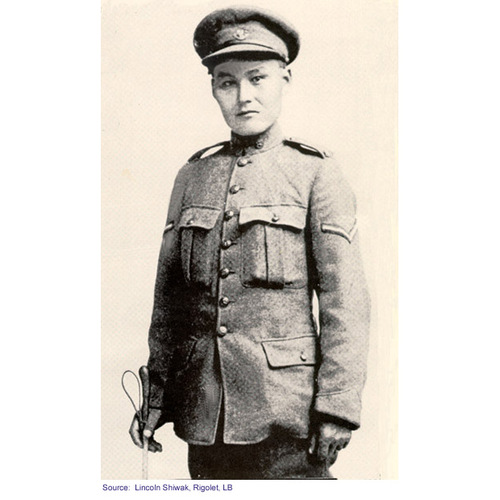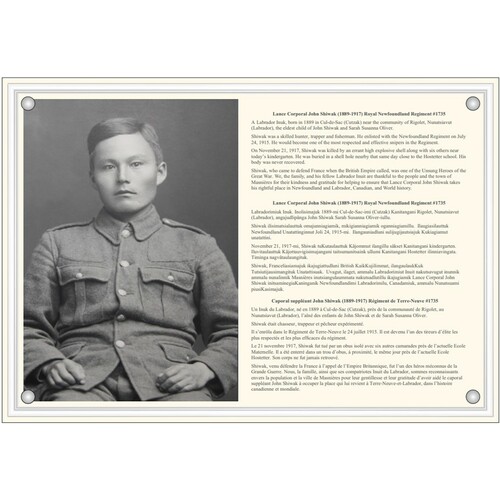
Source: Link
SHIWAK (Sikoak), JOHN, Inuit hunter, trapper, and soldier; b. February or March 1889 in Rigolet, Labrador, eldest son of John Shiwak and Sarah Susanna —; d. unmarried 20 or 21 Nov. 1917 near Masnières, France.
A doctor with the Grenfell Mission in Labrador, Harry Locke Paddon*, apparently changed the Shiwaks’ surname arbitrarily from Sikoak, which means “relating to thin ice.” The Shiwak family lived at Cul-de-Sac, near Rigolet, at the narrows to Lake Melville. Little is known of the early years of John Shiwak Jr, but it may be assumed that, like his male peers, he learned the practical skills required for northern living, including use of the boat, dog-team, and rifle, and perfected his competence by hunting, fishing, and trapping. Swatching, or shooting seals in open water as they briefly exposed their heads to breathe, provided unparalleled training for a future military sharpshooter.
Information on Shiwak’s life comes largely from the accounts of novelist William Lacey Amy, who met Shiwak in August 1911 on the coastal steamer from St John’s to Rigolet. Shiwak had left home in 1901 to seek his fortune. He may have worked for the Hudson’s Bay Company, which operated a fur and salmon factory at Rigolet and seasonally employed many local workers, including John’s younger brothers Wilfred and William. Amy noted that John worked during the summer for a doctor (most likely Paddon) and that, for several winters prior to enlisting, he trapped. One year Shiwak trapped on the thirds, that is, he leased a trapline – the Groves Point trapline on Goose Bay from prominent settler-trapper John Groves – in exchange for one-third of the catch. His trapping during the winter of 1910–11 financed the trip on which he encountered Amy.
Following their meeting, the two corresponded regularly and Amy came to characterize the self-taught Shiwak as a natural artist and writer. According to Amy, Shiwak mentioned in his letters his desire to be a soldier. This ambition may have been kindled by his excursion (or excursions) to St John’s, by Harry Paddon’s patriotic zeal, or by his involvement with the Grand River or Mud Lake branches of the Legion of Frontiersmen, a British paramilitary corps founded in 1904 and established in Newfoundland and Labrador in 1911. After the outbreak of World War I, Shiwak’s enthusiasm enabled him to persuade two other local Inuit and a white man to enlist. Altogether, more than 60 Labrador men would serve in the war; Shiwak was one of five from the Lake Melville area to be killed.
Slight of build – he was five feet five inches in height and weighed 132 pounds – Shiwak enlisted on 24 July 1915 in St John’s in the Newfoundland Regiment. Following training in Scotland, he reached the front in France on 24 July 1916, three weeks after the regiment’s devastating losses at Beaumont-Hamel (Beaumont) [see Francis Thomas Lind]. During the next 15 months of hellish trench warfare, Shiwak would impress all as an exceptional scout and marksman. One officer would call him the best sniper in the British army; Shiwak’s actions in this difficult business earned him promotion to lance-corporal on 16 April 1917. In his letters, however, he confessed that he could not understand the steady killing. At least one card was sent from France to “My Dear Louisa,” of whom Shiwak thought “every Day even when I am in the line.” The recipient was almost certainly Louisa Flowers of Valley Bight on Lake Melville, whose mother opposed her engagement to Shiwak.
Shiwak’s background may explain his initial shyness with other soldiers. Eventually, however, he made friends, among them Newfoundlander Howard L. Morry, whose unpublished memoirs describe their relationship in France. Morry remembered “Johnny Shirvack” as “a sniper and a good one. He was shy and lonely but I got to be quite friendly with him by talking of seal hunting, etc. We’d talk for hours and often he’d say will it ever be over. He sure was a great shot and had a lot of notches on his rifle. He said sniping was like swatching seals.”
Shiwak’s final months were shrouded in despondency and loneliness, emotions that increased following the death of a close friend and former trapping companion, possibly William McKenzie of Rigolet. On 20 Nov. 1917 – one witness later recorded the 21st – Shiwak and six others were killed by an exploding shell during an attack on the village of Masnières, in the battle of Cambrai. Buried in the village, Shiwak received the British War and Victory medals.
[Details concerning Shiwak were graciously supplied to the author by a great-nephew, Roger Shiwak of Rigolet, Labrador, on 11 July 1994, and by a niece, Eva Shiwak Baikie of Happy Valley-Goose Bay, Labrador, on 15 Nov. 1994. Howard L. Morry’s unpublished memoir, “My service in the World War, 1914–1917,” completed 3 Aug. 1957, is in the hands of Robert L. Ryan of Fermeuse, Nfld.
It is not known whether Shiwak’s letters to Amy have survived. His card to Louisa is in the possession of Roger Shiwak. Although dated 24 Aug. 1914, it must have been written much later. j.c.k.]
NA, RG 150, Acc. 1992–93/166, Royal Newfoundland Regiment, file 1735. [W.] L. Amy, “A British Eskimo; from the Arctic to death,” Daily Mail (London), 11 Jan. 1918; “An Eskimo patriot,” Canadian Magazine, 51 (May–October 1918): 212–18 (reissued in Them Days (Happy Valley-Goose Bay), 17 (1991–92), no.1: 3–15). Encyclopedia of Nfld (Smallwood et al.). Henry Gordon, The Labrador parson; journal of the Reverend Henry Gordon, 1915–1925, ed. F. B. Gill ([St Johns, 1972]). Elizabeth Goudie [Blake], Woman of Labrador, ed. D. [W.] Zimmerly (Toronto, 1973). “Labradoreans who joined up in World War I,” Them Days, 17, no.1: 15; no.4: 37. D. W. Zimmerly, Cain’s land revisited: culture change in central Labrador 1775–1972 (St John’s, 1975).
Cite This Article
John C. Kennedy, “SHIWAK (Sikoak), JOHN,” in Dictionary of Canadian Biography, vol. 14, University of Toronto/Université Laval, 2003–, accessed January 20, 2026, https://www.biographi.ca/en/bio/shiwak_john_14E.html.
The citation above shows the format for footnotes and endnotes according to the Chicago manual of style (16th edition). Information to be used in other citation formats:
| Permalink: | https://www.biographi.ca/en/bio/shiwak_john_14E.html |
| Author of Article: | John C. Kennedy |
| Title of Article: | SHIWAK (Sikoak), JOHN |
| Publication Name: | Dictionary of Canadian Biography, vol. 14 |
| Publisher: | University of Toronto/Université Laval |
| Year of publication: | 1998 |
| Year of revision: | 1998 |
| Access Date: | January 20, 2026 |





